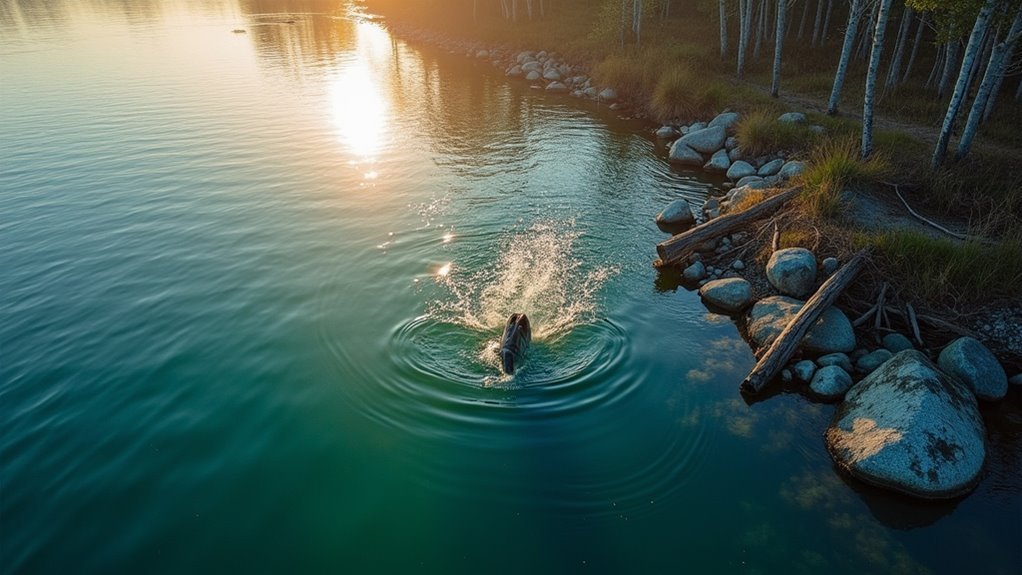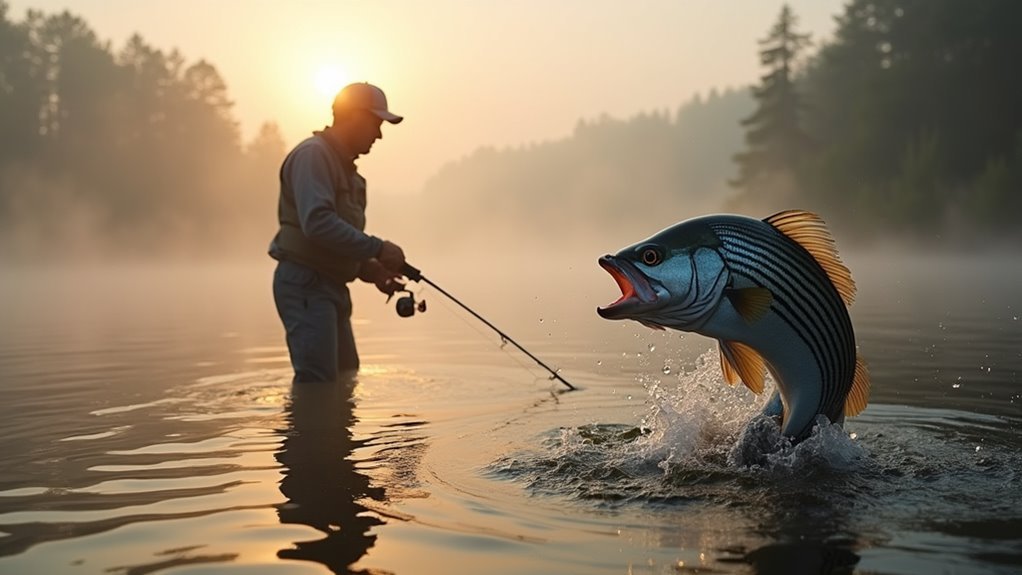To master freshwater striper fishing, anglers should focus on water temperature (ideally 55-68°F) and oxygen levels. Seasonal approaches matter—try shallow rocky points in spring, deeper waters in summer, and adjust after fall turnover. Trophy stripers often lurk near dams and current-bearing structures. Match your technique to conditions: drift live bait, vertical jig, or troll based on fish behavior. Dawn and dusk typically produce the most exciting action for those willing to adapt their strategy.
Understanding Striper Behavior and Environmental Triggers

When it comes to mastering freshwater striper fishing, understanding the behavior patterns of these powerful gamefish is absolutely essential.
Stripers operate within specific temperature ranges, preferring waters between 55°F and 68°F, and become significantly active once temperatures climb above 45°F.
Stripers thrive in the sweet spot of 55-68°F waters, with activity ramping up once temperatures exceed 45°F.
Their movements are heavily dictated by baitfish presence and oxygen levels—they require at least 5 mg/L to thrive.
Perhaps most importantly, current plays a vital role in their positioning. Stripers typically hang around seams and breaks where they can ambush prey with minimal energy expenditure.
Wind conditions and seasonal spawning behaviors also trigger predictable movements that savvy anglers can exploit for consistent success.
Seasonal Patterns: When and Where to Target Stripers
Throughout the year, stripers follow predictable seasonal patterns that dramatically affect where and how anglers should target them.
Spring brings them to shallow rocky points as waters warm into the 50s, with spawning activity near creek mouths and upper reservoirs by late spring.
Summer pushes these fish deeper as they recover from spawning, often relating to thermoclines and channel edges.
Fall fishing improves once water temperatures drop below 60°F after the turnover period, with surface activity becoming common.
Winter patterns start similarly to late fall, but stripers gradually move deeper (20-40 feet) as temperatures continue dropping.
Cold shocks can, intriguingly enough, trigger unexpected feeding frenzies.
Prime Freshwater Locations for Trophy Striped Bass
While stripers migrate according to seasonal conditions, the locations where trophy-sized specimens consistently appear deserve special attention from serious anglers.
Deep structures near major dams typically hold the largest fish, particularly in renowned waters like Lake Texoma, Smith Mountain Lake, and Lake Cumberland.
Trophy stripers congregate around dam structures in top destinations like Texoma, Smith Mountain and Cumberland.
Current-bearing rivers also produce exceptional catches, especially where tributary mouths create mixing zones rich with baitfish.
Perhaps the most overlooked trophy zones are submerged humps adjacent to main lake channels—these underwater “islands” often harbor the heaviest stripers.
For consistent success, I think anglers should focus on these prime locations during seasonal shifts when big fish become more predictable.
Proven Techniques That Land More Stripers

Several proven techniques have emerged from decades of striper fishing experience, each offering distinct advantages depending on water conditions and seasonal patterns.
These methods consistently produce results when matched with appropriate seasonal behaviors and baitfish movements that stripers naturally follow.
- Drifting Live Bait – Perhaps the most reliable technique, using circle hooks with shad or herring positioned at striper-holding depths.
- Vertical Jigging – Effective around structure when fish are holding deep.
- Trolling – Covers water efficiently at 2.5-3 mph, particularly good for locating scattered schools.
- Topwater Walking Baits – Creates explosive strikes during low-light periods when stripers are feeding near the surface.
Bait and Lure Selection for Different Conditions
The strategic selection of baits and lures can make the difference between a frustrating day on the water and a cooler full of striped bass. Understanding what works in various conditions is critical.
For spring fishing when stripers are active in shallower water, topwater lures and bucktail jigs that mimic local baitfish like shad often produce results.
As summer pushes fish deeper, live bait becomes more effective—threadfin shad or blueback herring seem to work best.
In fall, when stripers follow baitfish schools, perhaps trolling at 2.5 mph with hard baits might be your best approach.
Winter typically calls for slower presentations with jigging techniques in deeper structures.
Hybrid Striper Tactics: Adapting Your Approach
Hybrid stripers present unique challenges that require anglers to modify traditional striper fishing approaches.
Adapting to hybrid stripers means rethinking your striper tactics for these aggressive freshwater fighters.
These fish, also known as “wipers,” tend to be more aggressive and can tolerate wider temperature ranges than pure stripers, perhaps making them more predictable year-round.
- Use slightly smaller lures than for pure stripers – hybrids often prefer 3-4 inch baits
- Fish shallower areas, especially points adjacent to deep water
- Try faster retrieves during summer months when hybrids remain active
- Focus on dawn/dusk periods when hybrids frequently push baitfish to the surface
Frequently Asked Questions
How Do Lunar Phases Affect Striper Feeding Patterns?
Striped bass feeding activity often intensifies during full and new moon phases when tidal movements are strongest, creating current breaks that concentrate baitfish and trigger more aggressive feeding behavior.
Can Stripers See Color, and Does Lure Color Really Matter?
Stripers can perceive some colors but have limited color vision. Lure color matters most in relation to water clarity, with natural patterns working best in clear water and bright colors in murky conditions.
How Do Barometric Pressure Changes Influence Striper Activity?
Though some anglers dismiss its impact, barometric pressure shifts profoundly affect stripers. Falling pressure often increases feeding activity, while high stable pressure typically reduces it as stripers move deeper seeking comfort.
What’s the Best Way to Properly Handle and Release Stripers?
Properly handling stripers requires wet hands, horizontal lifting, minimal air exposure, and avoidance of gill contact. During summer releases, gently revive fish in the water before swimming away.
How Can I Effectively Fish for Stripers From Shore?
Shore anglers should target points, creek mouths, and rocky outcrops, using fresh bait or lures that mimic local forage. Dawn and dusk provide ideal feeding periods for striped bass.